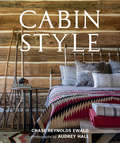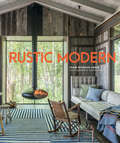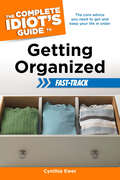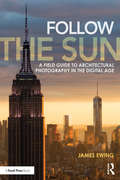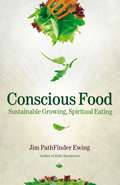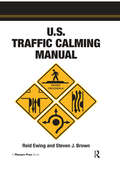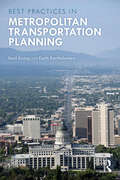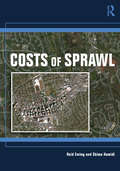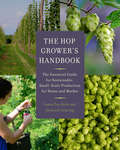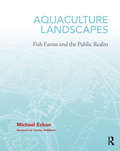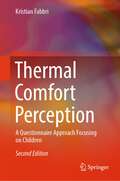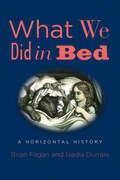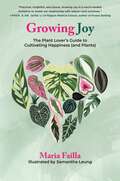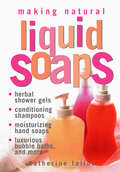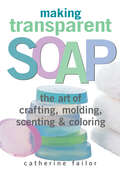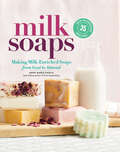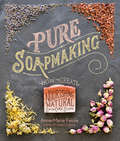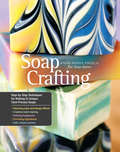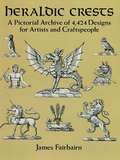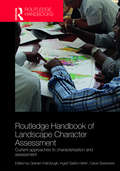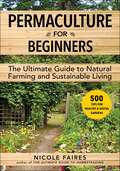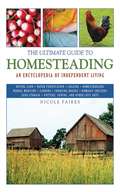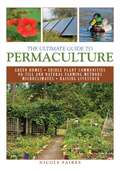- Table View
- List View
Cabin Style
by Chase Reynolds EwaldThe co-authors of American Rustic share inspirations for rustic elegance in home design for those who love living well in wild places. This gorgeously photographed volume offers visions of refined cabin style by top designers, builders, architects, and artists. From Napa to Nashville and along the Rocky Mountain spine, each project reflects the ways we live, and play, in nature. Whether a bison ranch, a log fishing cabin, a stone guest house, a lakeside retreat, a ski chalet, or a wine country barn, each home exhibits whimsical, playful, comfortable, and welcoming interiors and architecture—always inspired by the land. The homes curated in Cabin Style represent a fresh look at the genre, from traditional to transitional to modern. Interviews with architects, designers, builders and owners illuminate both the backstory and the creative process. Photographer Audrey Hall and writer Chase Reynolds Ewald have collaborated on five books, with their book American Rustic being named one of Best Home Design Books of 2015 by Architectural Digest.
Rustic Modern
by Chase Reynolds EwaldThis lushly photographed home design book offers an intimate tour through rustic modern residences across California and the Mountain West. Following their acclaimed volume American Rustic, design writer Chase Reynolds Ewald and photographer Audrey Hall have teamed up once again to explore fifteen Western homes with a fresh take on rustic style. Here you&’ll find contemporary approaches to traditional log cabins, sustainable projects, artist studios, and places for play. The inspired interior decor and exteriors are all beautifully photographed and discussed in elegant prose.Rustic Modern also offers detailed perspectives from the homeowners, architects, and designers who brought these diverse spaces to life. Individual home&’s stories are complemented by full-page photography. The rustic textiles, warm living spaces, uniquely crafted chandeliers suspend from vaulted ceilings, and sweeping vistas out every window are sure to inspire.
The Complete Idiot's Guide to Getting Organized Fast-Track: The Core Advice You Need to Get and Keep Your Life in Order
by Cynthia EwerTurn organzing your space into your next great project with this comprehensive guide!In our materialistic, time-crunched society, lifestyles are compromised by disorganization and clutter. In a 2008 National Association of Professional Organizers survey, 65 percent of respondents noted that their household was at least moderately disorganized, 71 percent said their quality of life would improve if they were better organized, and 96 percent of respondents indicated that they could save time every day by becoming more organized. A survey by IKEA reported that only 11 percent of Americans know where their Social Security cards are. Unfortunately, the problem has gotten so out of hand for so many, they have no idea where to begin.The Complete Idiot's Guide® to Getting Organized Fast-Track, finds readers where they are and helps them take the first steps toward a more organized and efficient life. In this book readers get: • The principles behind effective organizing that can be applied to any situation in the home or office. • A plan for clearing paper clutter and putting important documents where they can be found. • Commonsense thoughts on prioritizing and letting go of objects that are no longer useful. • A system for categorizing possessions that does not require people to buy more stuff to organize the stuff they already have. • Tips for tackling disorganization hot spots, including home offices or dens, kitchens, closets, master bedrooms, garages, attics, and basement areas. • Advice for staying ahead of messy family members or coworkers who can undo a person's hard work in an instant.
Follow the Sun: A Field Guide to Architectural Photography in the Digital Age
by James EwingFollow the Sun will guide you through all aspects of architectural photography, from the genre’s rich history to the exciting new approaches brought by the advent of the digital age. It explains how to use the powerful tools of digital photography while employing many of the skills and traditions of the established genre. Written to be accessible to professionals, amateurs, and students alike, this book will be useful for photographers exploring architecture as fine artists, on editorial assignments, or on commercial shoots. Key features include: • Example photographs and diagrams • Historical background of architectural photography • Advice on essential equipment • How to plan a shoot to your advantage • How to use tilt-shift lenses for architecture • Editing workflow and strategies • Interviews with architectural photographers Peter Aaron, Magda Biernat, Ty Cole, and Elizabeth Felicella.
Conscious Food
by Jim Pathfinder EwingWhen did growing and eating food cease to be considered sacred? How did food lose its connection with health? Why is our food system out of control? What simple steps can we each take to profoundly change our world as a healthier place for us all? Journalist, author Jim PathFinder Ewing answers these and other questions with his new book, Conscious Food: Sustainable Growing, Spiritual Eating. Ewing provides a background on the emergence of agriculture and the declining connection with food as society evolved, particularly during times of war, and scrutinizes today's "conventional" farming that relies upon deadly toxins and unsustainable fossil fuels. The book outlines how modern people can avoid being victims of biocultural evolution and the resultant entropy of declining global and personal health - and instead contribute to the movement toward mindful food choices and better world health, both physically and spiritually. Ewing discusses how society can nurture the unseen Spirit world that permeates plants through adopting nondenominational spiritual understandings, and includes how-to examples for growing organic food and fostering a supportive community and urban agriculture, as well as notes for expanded resources.
Best Development Practices: Doing the Right Thing and Making Money at the Same Time
by Reid EwingThe author draws upon case examples of some of today's most acclaimed developments in this book, and recommends best practice guidelines to help developers create vibrant, livable communities-and still make money. For years, Florida's planners and developers have had to deal with some of the most difficult growth management problems. Now planners and developers across the nation can benefit from the valuable lessons Florida offers on combating urban sprawl. Ewing first searched the state for the best contemporary developments, then distilled their lessons into guidelines for directing new development and assessing the quality of existing development. The 43 practices outlined in this exciting book cover four areas of development-land use, transportation, the environment, and housing. They apply to a broad range of development projects, including small planned communities, residential subdivisions, and commercial centers. The book's recommendations are based upon the experiences of successful developers and supported by empirical research. The proof lies in the compelling real-world examples Ewing highlights throughout the text. Illustrated with dozens of photographs and written in a lively style, this book is must reading for all those seeking better ways to plan and design communities. Developers will find proven, feasible land development regulations and benchmarks against which to evaluate development proposals.
Transportation & Land Use Innovations: When you can't pave your way out of congestion
by Reid EwingFirst published in 1997. Routledge is an imprint of Taylor & Francis, an informa company. This handbook introduces community leaders to an understanding of transportation mobility, offering suggestions to reduce congestion, automobile dependence, and vehicle miles of travel.
U.S. Traffic Calming Manual
by Reid EwingA comprehensive how-to manual for traffic calming in the United States. Planners and engineers can look to this manual for guidance on the appropriate use, design, and signing and marking of traffic-calming measures. For local officials, developers, and community associations, it is an introduction to the goals and tactics of traffic calming. Based in part on the first traffic-calming manual taken through a formal rule-making process and adopted by a state department of transportation as a supplement to its roadway design manual, this book catalogs principles that have been modified by many local jurisdictions to match local priorities and preferences. Standardization is key to the success of traffic-calming initiatives, and this book explains the processes, tools, and design needed to create a standard traffic-calming program. It also shows how municipalities can build needed flexibility into such programs. Signage and markings are also key, and a chapter is devoted to these issues. This is the book that states and municipalities need to create effective traffic-calming programs.
Best Practices in Metropolitan Transportation Planning: New Advances, Approaches, And Best Practices
by Reid Ewing Keith BartholomewPlanning at a metropolitan scale is important for effective management of urban growth, transportation systems, air quality, and watershed and green-spaces. It is fundamental to efforts to promote social justice and equity. Best Practices in Metropolitan Transportation Planning shows how the most innovative metropolitan planning organizations (MPOs) in the United States are addressing these issues using their mandates to improve transportation networks while pursuing emerging sustainability goals at the same time. As both a policy analysis and a practical how-to guide, this book presents cutting-edge original research on the role accessibility plays - and should play - in transportation planning, tracks how existing plans have sought to balance competing priorities using scenario planning and other strategies, assesses the results of various efforts to reduce automobile dependence in cities, and explains how to make planning documents more powerful and effective. In highlighting the most innovative practices implemented by MPOs, regional planning councils, city and county planning departments and state departments of transportation, this book aims to influence other planning organizations, as well as influence federal and state policy discussions and legislation.
Costs of Sprawl
by Reid Ewing Shima HamidiAcross the nation, the debate over metropolitan sprawl and its impact has become pivotal to urban planning. A decade and a half ago, Smart Growth America and the U.S. Environmental Protection Agency sought to raise the level of the debate by sponsoring groundbreaking research to quantitatively measure sprawl and its quality-of-life impacts. The resulting measures are widely used in urban research and public health. Costs of Sprawl provides a panoramic guide to urban form in America, measures sprawl for metropolitan areas, urbanized areas, and counties, and studies the relationship between sprawl and quality-of-life outcomes. From this preliminary investigation, it looks like the costs of sprawl are varied and substantial, and the alternative of compact development is far superior. An essential read for researchers, planners, urban designers, policy makers, and smart growth advocates in the U.S. and abroad, this book provides a comprehensive and detailed analysis of one of the most critical issues in planning today.
The Hop Grower's Handbook: The Essential Guide for Sustainable, Small-Scale Production for Home and Market
by Laura Ten Eyck Dietrich GehringWith information on siting, planting, tending, harvesting, processing, and brewing It's hard to think about beer these days without thinking about hops. The runaway craft beer market's convergence with the ever-expanding local foods movement is helping to spur a local-hops renaissance. The demand from craft brewers for local ingredients to make beer--such as hops and barley--is robust and growing. That's good news for farmers looking to diversify, but the catch is that hops have not been grown commercially in the eastern United States for nearly a century. Today, farmers from Maine to North Carolina are working hard to respond to the craft brewers' desperate call for locally grown hops. But questions arise: How best to create hop yards--virtual forests of 18-foot poles that can be expensive to build? How to select hop varieties, and plant and tend the bines, which often take up to three years to reach full production? How to best pick, process, and price them for market? And, how best to manage the fungal diseases and insects that wiped out the eastern hop industry 100 years ago, and which are thriving in the hotter and more humid states thanks to climate change? Answers to these questions can be found in The Hop Grower's Handbook--the only book on the market about raising hops sustainably, on a small scale, for the commercial craft beer market in the Northeast. Written by hop farmers and craft brewery owners Laura Ten Eyck and Dietrich Gehring, The Hop Grower's Handbook is a beautifully photographed and illustrated book that weaves the story of their Helderberg Hop Farm with the colorful history of New York and New England hop farming, relays horticultural information about the unusual hop plant and the mysterious resins it produces that give beer a distinctively bitter flavor, and includes an overview of the numerous native, heirloom, and modern varieties of hops and their purposes. The authors also provide an easy-to-understand explanation of the beer-brewing process--critical for hop growers to understand in order be able to provide the high-quality product brewers want to buy--along with recipes from a few of their favorite home and micro-brewers. The book also provides readers with detailed information on: * Selecting, preparing, and designing a hop yard site, including irrigation; * Tending to the hops, with details on best practices to manage weeds, insects, and diseases; and, * Harvesting, drying, analyzing, processing, and pricing hops for market. The overwhelming majority of books and resources devoted to hop production currently available are geared toward the Pacific Northwest's large-scale commercial growers, who use synthetic pesticides, fungicides, herbicides, and fertilizers and deal with regionally specific climate, soils, weeds, and insect populations. Ten Eyck and Gehring, however, focus on farming hops sustainably. While they relay their experience about growing in a new Northeastern climate subject to the higher temperatures and volatile cycles of drought and deluge brought about by global warming, this book will be an essential resource for home-scale and small-scale commercial hops growers in all regions.
Aquaculture Landscapes: Fish Farms and the Public Realm
by Michael EzbanAquaculture Landscapes explores the landscape architecture of farms, reefs, parks, and cities that are designed to entwine the lives of fish and humans. In the twenty-first century, aquaculture’s contribution to the supply of fish for human consumption exceeds that of wild-caught fish for the first time in history. Aquaculture has emerged as the fastest growing food production sector in the world, but aquaculture has agency beyond simply converting fish to food. Aquaculture Landscapes recovers aquaculture as a practice with a deep history of constructing extraordinary landscapes. These landscapes are characterized and enriched by multispecies interdependency, performative ecologies, collaborative practices, and aesthetic experiences between humans and fish. Aquaculture Landscapes presents over thirty contemporary and historical landscapes, spanning six continents, with incisive diagrams and vivid photographs. Within this expansive scope is a focus on urban aquaculture projects by leading designers—including Turenscape, James Corner Field Operations, and SCAPE—that employ mutually beneficial strategies for fish and humans to address urban coastal resiliency, wastewater management, and other contemporary urban challenges. Michael Ezban delivers a compelling account of the coalitions of fish and humans that shape the form, function, and identity of cities, and he offers a forward-thinking theorization of landscape as the preeminent medium for the design of ichthyological urbanism in the Anthropocene. With over two hundred evocative images, including ninety original drawings by the author, Aquaculture Landscapes is a richly illustrated portrayal of aquaculture seen through the disciplinary lens of landscape architecture. As the first book devoted to this topic, Aquaculture Landscapes is an original and essential resource for landscape architects, urbanists, animal geographers, aquaculturists, and all who seek and value multispecies cohabitation of a shared public realm.
Thermal Comfort Perception: A Questionnaire Approach Focusing on Children (Springerbriefs In Applied Sciences And Technology Ser.)
by Kristian FabbriThis book offers a comprehensive exploration of children's understanding and experiences of thermal comfort. The book provides a methodology for evaluating comfort that takes into account the unique perspectives of children. The first part of the book provides an overview of the history of thermal comfort, the human body and environmental parameters, and common thermal comfort indexes. It also offers guidelines for creating questionnaires that accurately assess children's perceptions of indoor thermal comfort. The book then delves into children's understanding of the concepts of comfort and energy, as well as the factors that influence their perception of these concepts. It addresses the psychological and pedagogical aspects of thermal comfort judgment, as well as the architectural and environmental characteristics that contribute to children's perceptions of comfort. First published as Indoor Thermal Comfort Perception, this updated edition also includes new sections on architecture and sensitivity, exploring the impact of classroom spaces on learning, and outdoor education and thermal comfort outdoors, based on qualitative research. These additions provide valuable insights for future studies on these topics. While physical parameter measurements and comfort indexes are useful in thermal comfort, the book emphasizes the importance of ergonomic assessments in the form of questionnaires, which offer unique insights into children's experiences. The book fills a critical gap in understanding children's perceptions of thermal comfort and is essential reading for HVAC engineers, architects, environmental psychologists, and researchers in the medical and cognitive fields.
What We Did in Bed: A Horizontal History
by Brian Fagan Nadia DurraniA social history that pulls back the covers on the most intimate piece of furniture in our lives: &“Entertaining . . . will keep you awake long into the night.&” —Paul Chrystal, author of The History of Sweets Louis XIV ruled France from his bedchamber. Winston Churchill governed Britain from his during World War II. Travelers routinely used to bed down with complete strangers, and whole families shared beds in many preindustrial households. Beds were expensive items—and often for show. Tutankhamun was buried on a golden bed, wealthy Greeks were sent to the afterlife on dining beds, and deceased middle-class Victorians were propped up on a bed in the parlor. In this sweeping social history that spans seventy thousand years, Brian Fagan and Nadia Durrani look at the endlessly varied role of the bed through time. This was a place for sex, death, childbirth, storytelling, and sociability as well as sleeping. But who did what with whom, why, and how could vary incredibly depending on the time and place. It is only in the modern era that the bed has transformed into a private, hidden zone—and its rich social history has largely been forgotten. Includes photographs
Growing Joy: The Plant Lover's Guide to Cultivating Happiness (and Plants)
by Maria FaillaPlanty practices to grow your way to happier, more peaceful lifeDiscover the power of plants to help you disconnect from the stress and anxiety of modern life and grow more joy in your world. Filled with practices to help plant lovers step away from their screens and cultivate delight and peace of mind with plants, Growing Joy is your guide to transforming plant care into self-care. In easy to read, light-hearted chapters, author Maria Failla, host of the beloved podcast Bloom and Grow Radio, explores the science behind our love of plants and shares how that humble aloe plant on your windowsill can unlock a world of wellness and delight. With ideas and tips both big and small—from simply making a habit of looking at a plant before looking at a screen in the morning to creating a plant-infused restorative retreat in your home—Growing Joy will help you create a meaningful wellness practice rooted in nature and connection. And of course, there’s some plant care tips in there too to make sure both you and your green friends thrive! Whether you’re a plant parent pro or the anxious owner of a single, not-dead-yet succulent, Growing Joy will help you reconnect with yourself, bring more smiles to your face and peace in your heart, and inspire a lifelong relationship with plants that will keep you blooming and growing.
Making Natural Liquid Soaps: Herbal Shower Gels, Conditioning Shampoos, Moisturizing Hand Soaps, Luxurious Bubble Baths, and more
by Catherine FailorMake our own liquid soaps and body products right in your kitchen. Catherine Failor shows you how to use her simple double-boiler technique to create luxurious shower gels, revitalizing shampoos, energizing body scrubs, and much more. Step-by-step instructions teach you how to turn basic ingredients like cocoa butter, lanolin, and jojoba into sweet-smelling liquid soaps. You’ll soon be experimenting with your favorite oils and additives as you craft custom-made products that are kind to your nose and gentle on your skin.
Making Transparent Soap: The Art Of Crafting, Molding, Scenting & Coloring
by Catherine FailorWith basic ingredients and standard kitchen tools you can craft your own transparent soaps that are milder, richer, and creamier than any commercial product. Eschewing complex methods and expensive equipment, Catherine Failor uses a simple, dependable process that makes beautiful transparent soaps every time. Failor’s easy-to-follow photographic instructions are accompanied by proven recipes and plenty of suggestions for colorful and sweet-smelling variations. You’ll soon be creating your own signature soap blends that deliver refreshing scents and are gentle enough for even the most sensitive skin.
Milk Soaps: 35 Skin-Nourishing Recipes for Making Milk-Enriched Soaps, from Goat to Almond
by Anne-Marie FaiolaHandmade soap is made extra-special with the addition of milk! Soaps enriched with milk are creamier than those made with water, and milk’s natural oils provide skin-renewing moisture and nourishment. In Milk Soaps, expert soapmaker Anne-Marie Faiola demystifies the process with step-by-step techniques and 35 recipes for making soaps that are both beautiful and useful. She explains the keys to success in using a wide range of milk types, including cow, goat, and even camel milk, along with nut and grain milks such as almond, coconut, hemp, rice, and more. Photographs show soapmakers of all levels how to achieve a variety of distinctive color and shape effects, including funnels, swirls, layers, and insets. For beginners and experts alike, this focused guide to making milk-enriched soaps offers an opportunity to expand their soapmaking skills in new and exciting ways. This publication conforms to the EPUB Accessibility specification at WCAG 2.0 Level AA.
Pure Soapmaking: How to Create Nourishing, Natural Skin Care Soaps
by Anne-Marie FaiolaThe pure luxury of soaps made with coconut butter, almond oil, aloe vera, oatmeal, and green tea is one of life&’s little pleasures. And with the help of Anne-Marie Faiola, author of Soap Crafting and Milk Soaps, it&’s easy to make luscious, all-natural soaps right in your own kitchen. This collection of 32 recipes ranges from simple castile bars to intricate swirls, embeds, and marbled and layered looks. Begin with a combination of skin-nourishing oils and then add blueberry puree, dandelion-infused water, almond milk, coffee grounds, mango and avocado butters, black tea, or other delicious ingredients — and then scent your soap with pure essential oils. Step-by-step photography guides you through every stage of cold-process soapmaking.
Soap Crafting: Step-by-Step Techniques for Making 31 Unique Cold-Process Soaps
by Anne-Marie FaiolaMake your own custom-tailored and perfectly formed cold-process soaps! Learn how to use milk jugs and yogurt containers for molds, and how coffee, avocado, and even beer can add unique dimensions to your creations. This encouraging introduction to the art of soapmaking makes it simple to master the techniques you need to safely and easily produce your own enticingly fragrant soaps.
Heraldic Crests: A Pictorial Archive of 4,424 Designs for Artists and Craftspeople (Dover Pictorial Archive)
by James FairbairnRich selection of royalty-free motifs from famous British reference. Striking, varied designs suitable for any number of graphic projects. Images include lions, tigers, wreaths, falcons, rosettes, human figures, mythical creatures, crowns, and much more. Add aristocratic flair to book and magazine illustrations, advertisements, newsletters, etc.
Routledge Handbook of Landscape Character Assessment: Current Approaches to Characterisation and Assessment
by Graham Fairclough Ingrid Sarlöv Herlin Carys SwanwickIn this multi-authored book, senior practitioners and researchers offer an international overview of landscape character approaches for those working in research, policy and practice relating to landscape. Over the last three decades, European practice in landscape has moved from a narrow, if relatively straightforward, focus on natural beauty or scenery to a much broader concept of landscape character constructed through human perception, and transcending any of its individual elements. Methods, tools and techniques have been developed to give practical meaning to this idea of landscape character. The two main methods, Landscape Character Assessment (LCA) and Historic Landscape Characterisation (HLC) were applied first in the United Kingdom, but other methods are in use elsewhere in Europe, and beyond, to achieve similar ends. This book explores why different approaches exist, the extent to which disciplinary or cultural specificities in different countries affect approaches to land management and landscape planning, and highlights areas for reciprocal learning and knowledge transfer. Contributors to the book focus on examples of European countries – such as Sweden, Turkey and Portugal – that have adopted and extended UK-style landscape characterisation, but also on countries with their own distinctive approaches that have developed from different conceptual roots, as in Germany, France and the Netherlands. The collection is completed by chapters looking at landscape approaches based on non-European concepts of landscape in North America, Australia and New Zealand. This book has an introductory price of £125/$205 which will last until 3 months after publication - after this time it will revert to £140/$225.
Permaculture for Beginners: The Ultimate Guide to Natural Farming and Sustainable Living
by Nicole FairesTake your garden to the next level—organic, native, and natural! Permaculture is an important but often misunderstood method of growing food and building homes in a manner that works with nature, rather than against it, to create beautiful, healthy, and useful gardens. Blending ecology, organic agriculture, green home design, appropriate technology, and biology can be confusing and overwhelming, but Permaculture for Beginners simplifies this vast field for practical application. This is a hands-on guide, taking the beginner through each step of the design process, so that anyone can apply permaculture principles to their own life. While the principles are simple, the in-depth topics cover every aspect of permaculture, including: Building green homes and passive solar design Growing edible plant communities and forest gardens Using no-till and natural farming methods Creating microclimates for extended growing seasons Raising livestock with ecological foraging techniques Transforming urban backyards into food-abundant oasesThis is a commonsense approach to sustainable living that creates a self-sufficient and low-effort home for the people that live there, whether in the city or the country. Permaculture for Beginners isn&’t a philosophy book, or a dissertation on theory. It is a step-by-step, complete guide to every aspect of permaculture.
The Ultimate Guide to Homesteading: An Encyclopedia of Independent Living (The Ultimate Guides)
by Nicole FairesCan you make your own bread (sans bread machine)? Grow a garden all winter? What can you use instead of toilet paper? What if the power went out for a month? What if the grocery store closed? Can you make a solar oven? Store food without electricity? Raise a water buffalo? Make fine linen from stinging nettle? Make your own shampoo? Deliver a baby? Is it possible to be totally self-sufficient? This massive, full-color book answers all these questions and thousands more and includes checklists, diagrams, and instructions on how to buy a sheep. All of the information included meets these criteria: It is something that anyone can do, without special training. It can be done with relatively few supplies or with stuff you can make yourself. It has been tried and tested--either by the author, the military, doctors, or other homesteaders. The Ultimate Guide to Homesteading is not a storybook or a cookbook. It is a practical guide with nitty-gritty details on everything a homesteader can do, step-by-step with hundreds of color illustrations and pen and ink sketches. You can do it! This book can help.
The Ultimate Guide to Permaculture: Permaculture For Beginners (Ultimate Guides)
by Nicole FairesPermaculture is an important but often misunderstood method of growing food and building homes in a manner that works with nature, rather than against it, to create beautiful, healthy, and useful gardens. Blending ecology, organic agriculture, green home design, appropriate technology, and biology can be confusing and overwhelming, but The Ultimate Guide to Permaculture simplifies this vast field for practical application. This is a hands-on guide, taking the beginner through each step of the design process, so that anyone can apply permaculture principles to their own life. While the principles are simple, the in-depth topics cover every aspect of permaculture, including:- Building green homes and passive solar design - Growing edible plant communities and forest gardens - Using no-till and natural farming methods - Creating microclimates for extended growing seasons - Raising livestock with ecological foraging techniques This is a common-sense approach to sustainable living that creates a self-sufficient and low-effort home for the people that live there, whether in the city or the country. The Ultimate Guide to Permaculture isn't a philosophy book, or a dissertation on theory. It is a step-by-step, complete guide to every aspect of permaculture.
